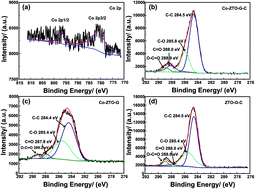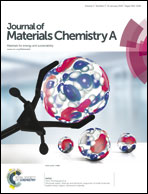One-step synthesis of Co-doped Zn2SnO4–graphene–carbon nanocomposites with improved lithium storage performances†
Abstract
Co-doped Zn2SnO4–graphene–carbon nanocomposites have been prepared for the first time through a convenient one-step hydrothermal method. The size of Co-doped Zn2SnO4 nanoparticles is about 3–5 nm and they are well dispersed on graphene nanosheets and carbon layer. L-Ascorbic acid is introduced to serve as a reductant for GO and carbon sources. The doping of Co can enhance the crystalline degree of Zn2SnO4 nanoparticles. When evaluated as anode materials for lithium ion batteries, the Co–ZTO–G–C nanocomposites exhibited a significantly higher reversible capacity of 699 mA h g−1 after 50 cycles at 100 mA g−1 and an improved cycling stability of 461 mA h g−1 after 200 cycles at 500 mA g−1 compared with Co–ZTO–G and ZTO–G–C nanocomposites. Moreover, even at a high current density of 1000 mA g−1, the reversible capacity of 418 mA h g−1 still remained. The improved electrochemical performance can be attributed to the synergy of the graphene substrate, the protective carbon layer, the uniform ultrafine Zn2SnO4 nanoparticles and Co doping. Therefore, Co–ZTO–G–C nanocomposites show great prospect as anodes for lithium-ion batteries.


 Please wait while we load your content...
Please wait while we load your content...